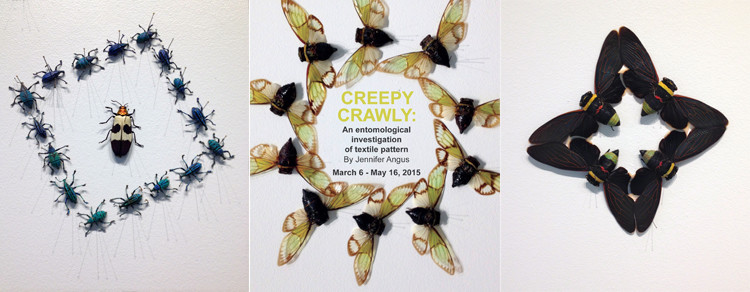March 6 – May 16, 2015 • Extended through Friday, May 22, 2015 • Joan Mondale Gallery
Creepy Crawly: an entomological investigation of textile pattern
Opening Reception: Friday, March 6, 6 – 8 pm
Jennifer Angus’ whimsical, provocative exhibition features thousands of real insects pinned directly to Textile Center’s gallery walls in continuous patterns that reference familiar textiles. Pushing the boundaries of fiber art, this wallpaper-like installation envelopes the viewer in a push-pull of attraction to the beautiful surface design and revulsion at the creepy crawlies.
Read about the artist as insect advocate
Jennifer Angus Artist Talk
Wings of Design–Textile Patterns Found in the World of Insects
Thursday, March 12, 6 – 7 pm • Bill Johnson Artist Talk • Free and open to the public.
This event is presented in conjunction with Creepy Crawly: An entomological investigation of textile pattern.
Jennifer Angus Bio
Jennifer Angus is a professor in the Design Studies department at the University of Wisconsin – Madison. She received her education at the Nova Scotia College of Art and Design (BFA) and at the School of the Art Institute of Chicago (MFA). Jennifer has exhibited her work internationally including Australia, Canada, France, Germany, Japan and Spain. She has been the recipient of numerous awards including Canada Council, Ontario Arts Council, and Wisconsin Arts Board grants. At the University of Wisconsin-Madison, she has received annual grants from the Graduate School, as well as the Vilas Associate Award, the Emily Mead Baldwin-Bascom Professorship in the Creative Arts, the Romnes Fellowship, and most recently the UW Arts Institute Creative Arts Award. The Ontario Association of Art Galleries selected her exhibition A Terrible Beauty at the Textile Museum of Canada as “Exhibition of the Year” in 2006. In 2013, Albert Whitman and Company, Chicago, published her first novel, In Search of Goliathus Hercules. She maintains a comprehensive web site of her work: jenniferangus.com
Artist Statement
For more than 10 years, I have been creating installations composed of insects pinned directly to a wall in repeating patterns which reference both textiles and wallpaper. When viewers enter one of my installations, they are greeted with something they think they know, that is, a patterned wallpaper which could be in anyone’s home. However upon closer examination, one discovers that it is entirely made up of insects. A tension is created by the beauty one observes in the pattern and the apprehension we feel toward insects. I know very few people who welcome insects into their home. In fact, we have a certain hysteria about them. Culturally, insects are a sign of dirtiness and disease. My work explores ideas of home and comfort. It alludes to the unseen world of dust mites, germs and bacteria, both friendly and not.
My work also takes inspiration from the Victorian era, for it was a time of great collecting. For the insatiable Victorian collector, nothing was sacrosanct. The attention to intricate detail as well as the sheer number of insects comprising the work often overwhelms viewers. The result is a kind of Victorian fancy, for they are over-the-top environments in which the evidence of “horror vacui” (fear of empty space) is in full display.
Perhaps you have walked on a warm summer evening and seen fireflies dancing in the sky. There is something magical about the sight, and one wishes one could be part of the festivities and the mystery. Such a desire may seem childish, and I note that indeed children’s literature is populated with wonderful six legged characters such as the insect companions in James and the Giant Peach or the fabulously glamorous cockroach in La Cuchuracha Martina. In fact, what is considered the first children’s story in the English language which was not a moral tale or fable is The Butterflies Ball and The Grasshoppers Feast by William Roscoe dating from 1808.
In the Victorian era, both adults and children were introduced to the natural world through a large number of educational publications in which insects were anthropomorphized so as to have greater appeal to the general reading public. I had often made a connection between my work and children’s literature because curiosity, imagination and magic are key ingredients. As children become adolescents and then adults, insects become dirty and repellent. Adults are often jaded. Rarely do we feel amazed in this busy world, but I do hope that those who take the time to visit one of my installations will simply walk in, say “Wow!” and for a moment experience that wonder they felt as a child.
Beyond insects, what unites all of my projects is my interest in the narrative. For example, in 2004, I mounted an exhibition entitled Goliathus Hercules at the John Michael Kohler Arts Center. Goliathus Hercules is the name of the fictitious insect I discovered and collected! The name alludes to the Latin nomenclature insects are given, and obviously it is a very large and strong creature. The bigger the insect, the more awe and prestige it will garner. Goliathus Hercules was created with the body parts of other insects (in the great hoax tradition). Included in the exhibition was a diary I created as a record of the explorer’s arduous jungle journey in the name of science and fame. Not coincidentally, the diary begins on April 1st.
The story didn’t seem finished there, and so I created a trilogy of episodic exhibitions entitled A Terrible Beauty. Each show or chapter has explored aspects of collecting from the viewpoint of the eccentric Victorian collector and furthered the story. As my work has evolved, I have been creating my own cabinets of curiosity in which Victorian poems about insects have been etched onto the backs of metallic beetles. In a larger cabinet type piece, I used a set of old library card catalogue drawers to create narrative scenes in which insect armies battle in each drawer. Viewers can pull out a single drawer, or if they pulled out five in a horizontal row, they could see the entire narrative of that particular act. For me one of the most exciting parts of this work is that there is a sense of exploration. As I provide no explanation or guidance to the viewer those who spend the longest with the work discover that pulling out multiple drawers at once creates the complete narrative.
For some time I have been using beeswax. In my first works I created dioramas in which insects appear to enact scenes from famous fairy tales such as Sleeping Beauty and Hansel and Gretel. Typically a diorama creates a realistic scene. However in mine, the insects inhabited a monochromatic brown world of beeswax. The subdued landscape is both surreal and provocative. The dioramas inspired further works in which vintage style dollhouses were covered in wax along with the furniture too. Again insects appear to live and carry out activities in these spaces. The houses with their 6-legged occupants are reminiscent of the work of Walter Potter (1835-1918), the celebrated taxidermist whose Kitten Wedding included 20 felines taxidermied and dressed for the occasion. His Rabbit School saw 48 bunnies posed at desks and studiously note taking upon slates.
As I mentioned previously, children’s literature in particular often has animal characters that are anthropomorphized so that the reader can relate, thus giving both insight and empathy. Author Beatrix Potter turned the tables so that, despite the fact that Peter Rabbit naughtily gorged himself on Farmer McGregor’s crops, the reader cheers for Peter rather than the aggrieved farmer. In her “Tale of Two Bad Mice”, the rodents create mayhem and destruction in a dollhouse, yet all is forgiven when they offer restitution of sixpence and a daily cleaning service.
Similarly I seek to rehabilitate the image of insects and draw correlations between humans and members of the six-legged kingdom. The fear we have of insects is generally unwarranted. Their role in the environment is vital, whether it be in the pollination of flowers which in turn produce the fruits we so enjoy, or the decomposition of matter. They don’t deserve a blast of “Raid” or a beating with a flyswatter.
It is perhaps worth mentioning that my first novel, In Search of Goliathus Hercules, was published by Albert Whitman & Co. of Chicago in 2013. The book considerably expands upon my original story of Goliathus Hercules. Ever so briefly the story follows our hero, Henri Bell, a boy who discovers he has the unique ability to speak to insects. From the title, you will understand that he sets about on a quest.
Postscript
There is often confusion as to whether the insects in my work are real. Yes, they are although they are dead and dried. The colours are their natural colour. I have not painted them. I have spent considerable time in Southeast Asia, particularly in Thailand and Malaysia where most of the insects I work with come from. While none of these species are endangered, it is important to note that their habitat is under assault. Unsurprisingly forests play second fiddle to human demands for agriculture and urbanization. Intellectually we recognize that forests are the lungs of the planet but not enough is being done to protect this precious resource. Virtually every insect on the endangered species list is there because of loss of habitat.
Ever heard the saying that where there is one cockroach there are 100? Most species (but not all) reproduce at a tremendous rate. Collecting insects is ecologically sound if done in a thoughtful manner, but unfortunately it is not always practiced. A number of butterflies and some beetles are now being farm raised with the express purpose of marketing to collectors. When I am able, I use farmed insects.
Many people who visit my exhibitions were never aware that such unusual insects exist. I hope that my exhibition will get them excited, and perhaps they will be motivated to get involved with one of the many rain forest preservation projects out there. I would also like people to think about their own environment and behavior. How is urban and suburban encroachment affecting wildlife big and small in your neighborhood? It is easy to take up the case of larger mammals, birds and fish but what about smaller creatures who have an important role in the ecosystem to play, be it pollinating flowers or helping in the decomposition of various matter?
Finally I want to say that I reuse and reuse the insects I have. After an exhibition, I pin them on to foam boards and put them into boxes until the next exhibition. If something is damaged, I always try to repair it before it gets thrown away and those beyond repair I give to children for further study.

